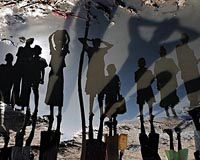| . |  |
. |
Libreville (AFP) Aug 16, 2010 Irradiation, river pollution and low fish stocks are among the effects noted of mining in Gabon by the non-governmental organisation Brainforest in an investigation published Monday. "Projects that engender billions in investment, for the most part foreign (...) with considerable economic fall-out, should not be undertaken at the expense of local populations and the environment," the report concludes. Brainforest studied the impact of mining mainly by the French companies Areva and Eramet in the eastern Haut-Ogooue region of the central African country. It chose three sites: Mounana, where uranium was mined for more than 40 years by COMUF (Uranium Mining Company of Franceville), a subsidiary of Areva; Moanda, where COMILOG (Mining Company of the Ogooue), a subsidiary of Eramet, has been mining manganese since 1962; and Poubara, where a large hydro-electric dam is being built to meet COMILOG's energy needs. "The lack of information concerning the radiological situation (in Mounana) is unacceptable," Brainforest said, noting the proximity of different parts of the town to zones where there is a high risk of radioactivity. Radiation levels are in principle measured by the National Centre for the Prevention and Protecting from Ionising Rays (CNPPRI), but the report said that the centre's independence "raises questions when we know that COMUF has for years been financing this organ 'independent' of the ministry of mines." Measurements taken by the CNPPRI have never been reported to the local authorities or the population, charged Brainforest, which called for an independent study to avoid potential bias. Areva ceased to mine uranium in Gabon about a decade ago, but mining could resume at fresh sites, the report said. At Moanda, watercourses have become blocked and polluted by mud and waste from COMILOG's manganese mining operation. Local people have abandoned their traditional fishing haunts and now go several kilometres (miles) distant to hunt. In some districts, it is hard to find fresh water to drink. Brainforest said that manganese mining had considerably changed the lives of people living around Moanda, but the report added that COMILOG had "acknowledged the scale of the impact of its activities on the environment." At Poubara, "the biggest hydroelectric project in Gabon (will) submerge an area of 46.2 square kilometres (17.6 square miles)" without any consultations with the local population, nor studies of "compensation, nor the inventory of planned activities," Brainforest found. COMILOG, which wants the power from the dam, produced 3.3 million tonnes of manganese ore in 2007 and is the world's second largest producer of high-grade ore, according to Eremet.
Share This Article With Planet Earth
Related Links Our Polluted World and Cleaning It Up
 Study: Better pollution measuring a must
Study: Better pollution measuring a mustBoulder, Colo. (UPI) Aug 11, 2010 Pollution produced by the petroleum industry has fallen in recent years, a study says, but a big hurdle remains in accurately measuring the improvement. Researchers with the University of Colorado at Boulder and the National Oceanic and Atmospheric Administration say the industry still significantly underestimates the amounts of reactive chemicals being released into the air, a universi ... read more |
|
| The content herein, unless otherwise known to be public domain, are Copyright 1995-2010 - SpaceDaily. AFP and UPI Wire Stories are copyright Agence France-Presse and United Press International. ESA Portal Reports are copyright European Space Agency. All NASA sourced material is public domain. Additional copyrights may apply in whole or part to other bona fide parties. Advertising does not imply endorsement,agreement or approval of any opinions, statements or information provided by SpaceDaily on any Web page published or hosted by SpaceDaily. Privacy Statement |